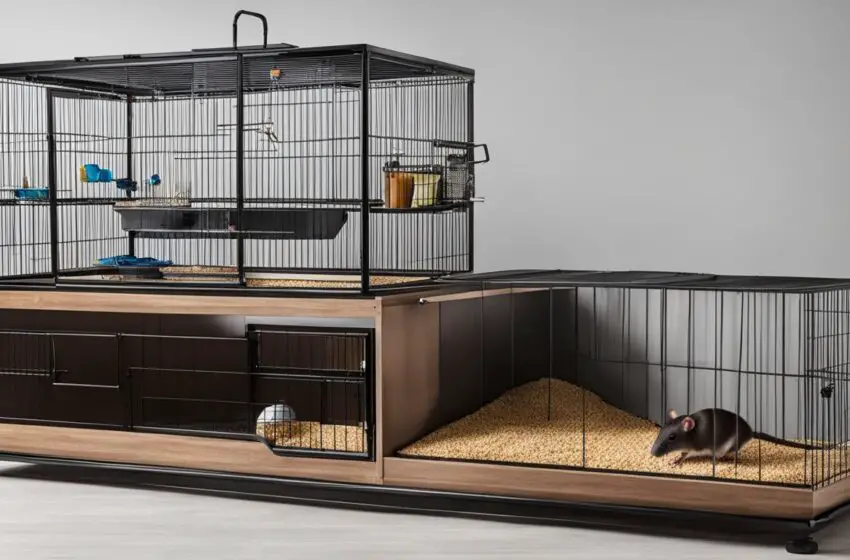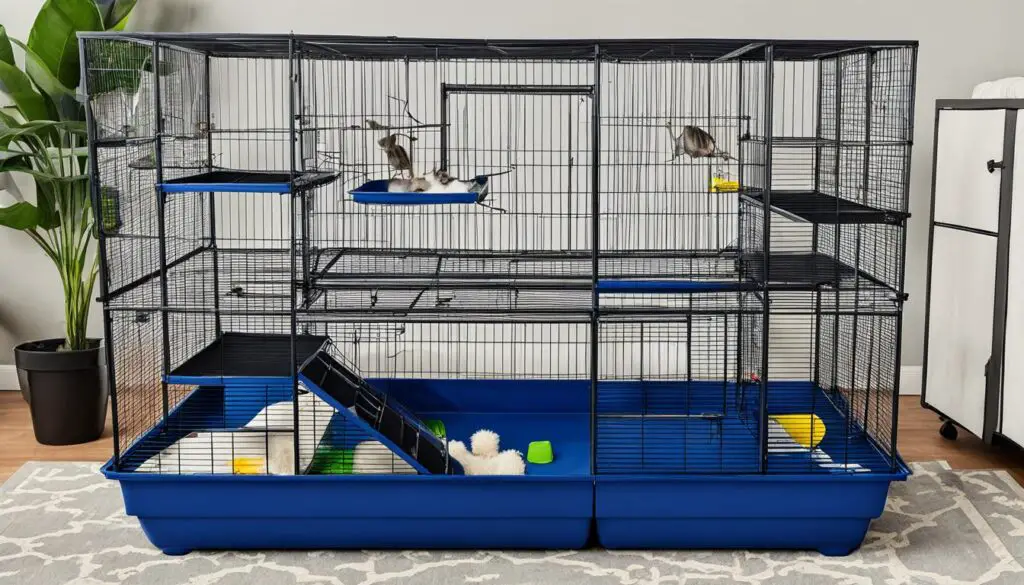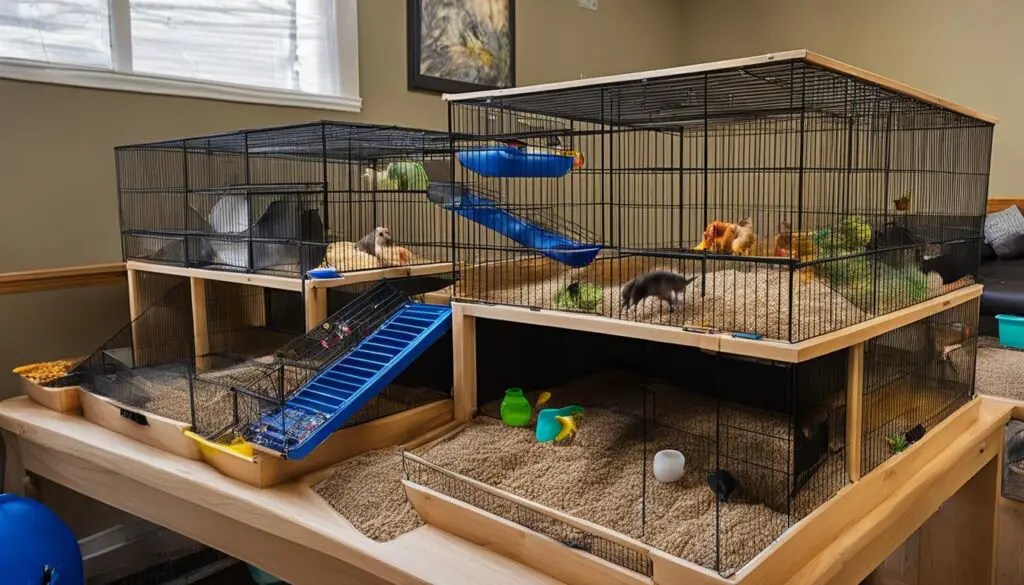Choosing the Right Cage Size for Your Pet Rat

When it comes to providing a suitable living space for your pet rat, selecting the right cage size is essential. The proper cage size ensures that your rat has enough room to move around, exercise, and engage in natural behaviors. To determine the ideal cage size for your pet rat, it is important to consider their physical needs and provide adequate space for their comfort and well-being.
Key Takeaways
- Choosing the proper cage size is crucial for your pet rat’s well-being.
- Consider your rat’s physical needs and provide adequate space for movement.
- A larger cage allows for exercise and reduces the risk of health issues.
- Provide hiding spots, toys, and enrichment activities in a spacious cage.
- Prioritize your pet rat’s comfort and ensure ample space for natural behaviors.
Factors to Consider When Choosing a Rat Cage Size
When selecting the right cage size for your pet rat, there are several important factors to consider. By taking these factors into account, you can ensure that your rat has a suitable living space that meets their needs. Here are some key factors to keep in mind:
Number of Rats
The number of rats you will be housing together is an essential consideration when determining the cage size. It is recommended to provide a minimum of 2 cubic feet of space per rat. This ensures that each rat has enough room to move around, play, and engage in natural behaviors.
Rat’s Physical Size and Activity Level
The physical size and activity level of your rat also play a role in determining the appropriate cage size. Larger rats may require more space to comfortably move around, while highly active rats may benefit from a larger cage that allows for more exercise. Assess your rat’s individual characteristics and choose a cage size that accommodates their needs.
“Choosing the right cage size is crucial for your pet rat’s well-being. Providing adequate space ensures they can move freely and engage in natural behaviors.”
By considering these factors, you can make an informed decision when selecting the perfect cage size for your pet rat. Remember, providing a suitable habitat is essential for their overall health and happiness.
Recommended Rat Cage Sizes
When it comes to providing a comfortable and safe living environment for your pet rat, selecting the right cage size is crucial. The size of the cage directly impacts your rat’s well-being, allowing them to engage in natural behaviors and move around freely. In this section, I will outline the recommended rat cage sizes based on the number of rats you have and their individual needs.
Minimum Rat Cage Size
For a single rat, the minimum recommended cage size is approximately 2 cubic feet of space. This ensures that your pet has enough room to exercise, explore, and have some freedom of movement within their enclosure. Providing adequate space is essential for your rat’s physical and mental health.
Ideal Rat Cage Size for Multiple Rats
If you are housing two rats together, it is recommended to provide at least 4 cubic feet of space. This allows the rats to have enough territory and minimizes the potential for territorial disputes. Providing a larger cage size for multiple rats is beneficial in terms of promoting harmonious social interactions and reducing stress levels.
As the number of rats increases, the cage size should also increase accordingly to ensure they have enough space to live comfortably. Larger cages, such as those with dimensions of 24×24 inches or more, are ideal for multiple rats. Having ample space allows them to establish their territories, engage in enrichment activities, and exhibit natural behaviors, promoting their overall well-being.

Remember, it’s important to take into account both the minimum and ideal cage sizes when considering the needs of your pet rats. Providing a suitable and spacious cage ensures their physical and mental stimulation, promoting a happy and healthy life for your furry friends.
| Number of Rats | Minimum Cage Size | Ideal Cage Size |
|---|---|---|
| 1 | Approximately 2 cubic feet | – |
| 2 | Approximately 4 cubic feet | – |
| 3+ | – | Larger cages, such as 24×24 inches or more |
Benefits of Providing an Adequate Cage Size for Rats
Providing an adequate cage size offers several benefits for your pet rat. Firstly, a spacious rat cage allows for more exercise and play, which contributes to their physical and mental well-being. Rats are active animals that require ample space to move around and engage in natural behaviors. A larger cage provides them with the freedom to stretch their legs, climb, and explore, promoting their overall health and happiness.
Moreover, a large rat habitat reduces the risk of health issues caused by limited mobility or inactivity. Rats that are confined in small, cramped cages may experience muscle atrophy, obesity, or joint problems. By providing a spacious cage, you can help prevent these health concerns and ensure that your pet rat maintains an active and healthy lifestyle.
“A proper rat cage size not only provides physical benefits but also creates a more stimulating environment for your pet.”
Furthermore, a larger cage offers numerous opportunities for enrichment. Rats are intelligent and curious creatures that require mental stimulation to prevent boredom and promote their well-being. With a spacious rat cage, you can include proper hiding spots, toys, and interactive activities that encourage exploration, problem-solving, and play. This enriching environment enhances their cognitive abilities and prevents behavioral issues such as aggression or excessive chewing.
Rat Cage Size Comparison Table
| Cage Type | Dimensions | Recommended for |
|---|---|---|
| Minimum Cage Size | Approximately 2 cubic feet | One rat |
| Medium Cage Size | Approximately 4 cubic feet | Two rats |
| Large Cage Size | 24×24 inches or more | Multiple rats |
As shown in the comparison table, providing a proper rat cage size is crucial for your pet’s well-being. It is important to note that these dimensions serve as a minimum guideline, and larger cages are always encouraged whenever possible.
By investing in a spacious rat cage, you are not only prioritizing your pet rat’s comfort and health but also creating a harmonious living environment. Your pet will have the freedom to exhibit natural behaviors, enjoy mental stimulation, and thrive in their home. Remember, a happy and healthy rat is a result of a suitable rat cage size.

Conclusion
Choosing the right cage size for your pet rat is crucial in ensuring their overall health and well-being. By taking into consideration factors such as the number of rats, their physical size, and activity level, you can determine the optimal cage size that will provide them with a comfortable living space.
Providing a suitable cage size offers numerous benefits for your pet rat. It allows them to move around freely, exercise, and engage in natural behaviors, promoting their physical and mental stimulation. A spacious cage also reduces the risk of health issues caused by limited mobility and inactivity.
Remember, prioritizing your pet rat’s comfort is key. Ensure they have ample space to move, explore, and express their natural instincts. By choosing the right cage size, you can create a happy and healthy habitat, where your pet rat can thrive and lead a fulfilling life.
FAQ
What is the proper cage size for rats?
The minimum recommended cage size for one pet rat is approximately 2 cubic feet of space. For two rats, it is recommended to provide at least 4 cubic feet. If you have a larger number of rats, the cage size should increase accordingly to ensure they have enough space to live comfortably.
How do I determine the ideal cage size for my pet rat?
To determine the ideal cage size for your pet rat, consider factors such as the number of rats, their physical size, and activity level. It is recommended to have a minimum of 2 cubic feet of space per rat.
What are the benefits of providing a spacious cage for rats?
Providing an adequate cage size offers several benefits for your pet rat. A spacious cage allows for more exercise and play, contributing to their physical and mental well-being. It reduces the risk of health issues caused by limited mobility or inactivity. Additionally, a larger cage provides ample room for hiding spots, toys, and enrichment activities, making it a more stimulating environment for your pet rat.
What are some factors to consider when selecting a rat cage size?
When selecting a rat cage size, consider factors such as the number of rats you will be housing together, their physical size, and activity level. Larger rats may require more space to comfortably move around, so it’s important to take their size into account.
Why is choosing the right cage size important for pet rats?
Choosing the right cage size is important for pet rats because it ensures they have enough room to move around, exercise, and engage in natural behaviors. It contributes to their overall comfort and well-being.



